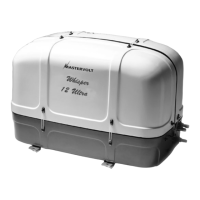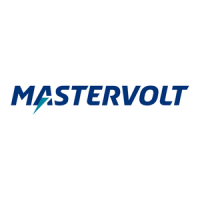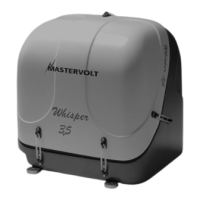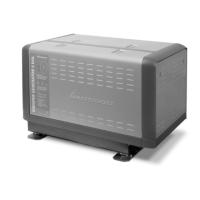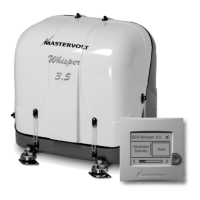8 EN / MOBILE WHISPER 6/12-6/8/10/12/16 ULTRA / November 2004
INSTALLATION
be mounted on rubber mountings. When the clicking
noises of the pump are not acceptable an other
noiseless pump is available as an option.
3 FUEL PIPES
When the tank is above the generating set we recom-
mend to end the return line on the top of the tank.
When the return is on the top - in case of a leakage -
the return line cannot overflow because of siphoning.
One will only need a fuel cock in the fuel supply line.
Both supply and return fuel pipe lines should be
appropriate material and 8 mm outer diameter tubing.
The quality of the tubing of fuel pipes could be sub-
mitted to local regulations depending on the applica-
tion of the vehicle.
The fuel pipes can be plumbed to the flexible hoses
which are on the generating set and have a connec-
tion to fit to 8 mm pipe. The fuel lines Mastervolt
supplies are according to ISO 7840 A2.
It is important to avoid bends in the pipes, as they
could trap air bubbles. The return pipe should never
be connected to the suction pipe. The return line
should be of 8 mm diameter and go straight back via
the top to the bottom of the tank. When the return is
too narrow, has too many bents and goes back to the
bottom of the fuel tank, the back-pressure could be to
high. This results in irregular running of the engine.
When the engine runs irregular, one can check if
back-pressure is the problem by disconnecting the
return line just outside the canopy and draining it in a
canister. When the engine runs smooth now, the
return piping has to be changed. It could also help to
install a second (electrical 12V) fuel lift pump.
4 FUEL FILTERS
A fine fuel filter is installed which requires maintenan-
ce. Mastervolt advises to install an extra fuel filter/
water fuel separator near the fuel tank.
Before starting your generating set for the first time
follow the fuel system bleeding procedure in the users
manual.
2.4.2 RADIATOR COOLING
1 General instructions
The radiators can be mounted below the floor, in the side
or on the roof of the vehicle.
Wherever the radiators are mounted the well functioning
of the system depends on the well circulation of the
coolant.
Roof mounted radiators bring the most risk for circulation
problems, because air trapped in the radiators or a low
level of the coolant, will immediately affect the cooling
capacity of the radiators.
It is recommended to keep the radiators as close as
possible to the unit. The piping should be fitted as direct
as possible.
When the radiators are above the engine, the piping should
be fitted below the top of the radiators! (refer to figure 12).
Bents in the piping, that can trap air bubbles, should be
avoided or ventilated (refer to figure 13).
Special attention should be paid to the ventilation of the
systems. Each installation system is standard supplied
with an expansion tank for the coolant, which is also
used to release air bubbles and makes it possible to add
coolant into the system in an easy way. This expansion
tank should be at the highest point of the system and
mounted as high as possible.
Most cooling problems originate from air
traps blocking the circulation of the engine
coolant.
No bent of piping above the radiator
Fig.12. Remove the air trap
Fig.13. Ventilating an air trap
